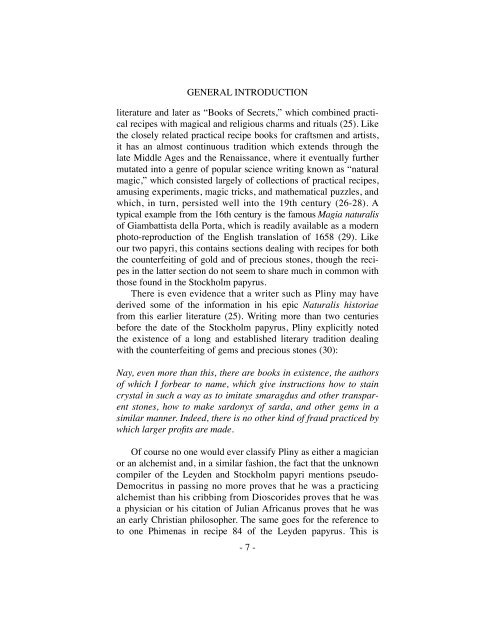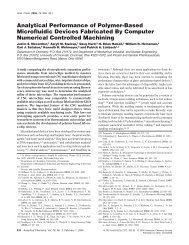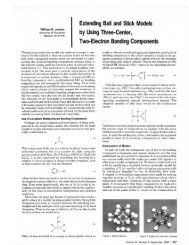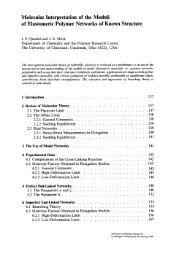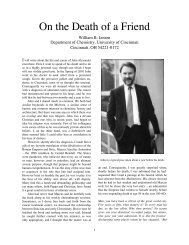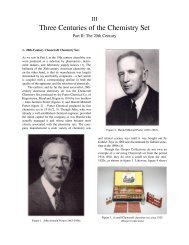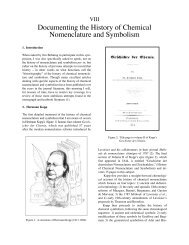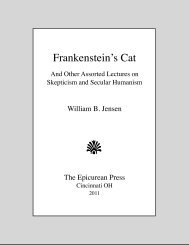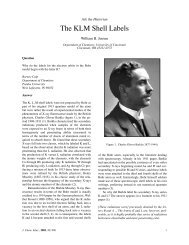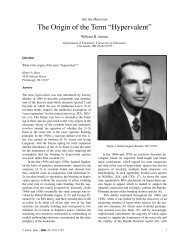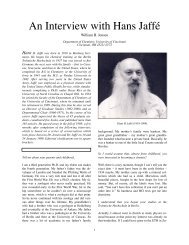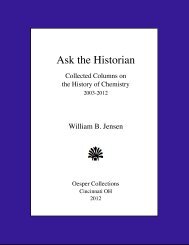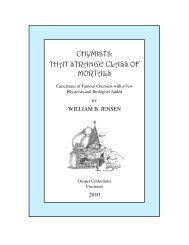The Leyden and Stockholm Papyri - University of Cincinnati
The Leyden and Stockholm Papyri - University of Cincinnati
The Leyden and Stockholm Papyri - University of Cincinnati
You also want an ePaper? Increase the reach of your titles
YUMPU automatically turns print PDFs into web optimized ePapers that Google loves.
GENERAL INTRODUCTION<br />
literature <strong>and</strong> later as “Books <strong>of</strong> Secrets,” which combined practical<br />
recipes with magical <strong>and</strong> religious charms <strong>and</strong> rituals (25). Like<br />
the closely related practical recipe books for craftsmen <strong>and</strong> artists,<br />
it has an almost continuous tradition which extends through the<br />
late Middle Ages <strong>and</strong> the Renaissance, where it eventually further<br />
mutated into a genre <strong>of</strong> popular science writing known as “natural<br />
magic,” which consisted largely <strong>of</strong> collections <strong>of</strong> practical recipes,<br />
amusing experiments, magic tricks, <strong>and</strong> mathematical puzzles, <strong>and</strong><br />
which, in turn, persisted well into the 19th century (26-28). A<br />
typical example from the 16th century is the famous Magia naturalis<br />
<strong>of</strong> Giambattista della Porta, which is readily available as a modern<br />
photo-reproduction <strong>of</strong> the English translation <strong>of</strong> 1658 (29). Like<br />
our two papyri, this contains sections dealing with recipes for both<br />
the counterfeiting <strong>of</strong> gold <strong>and</strong> <strong>of</strong> precious stones, though the recipes<br />
in the latter section do not seem to share much in common with<br />
those found in the <strong>Stockholm</strong> papyrus.<br />
! <strong>The</strong>re is even evidence that a writer such as Pliny may have<br />
derived some <strong>of</strong> the information in his epic Naturalis historiae<br />
from this earlier literature (25). Writing more than two centuries<br />
before the date <strong>of</strong> the <strong>Stockholm</strong> papyrus, Pliny explicitly noted<br />
the existence <strong>of</strong> a long <strong>and</strong> established literary tradition dealing<br />
with the counterfeiting <strong>of</strong> gems <strong>and</strong> precious stones (30):<br />
Nay, even more than this, there are books in existence, the authors<br />
<strong>of</strong> which I forbear to name, which give instructions how to stain<br />
crystal in such a way as to imitate smaragdus <strong>and</strong> other transparent<br />
stones, how to make sardonyx <strong>of</strong> sarda, <strong>and</strong> other gems in a<br />
similar manner. Indeed, there is no other kind <strong>of</strong> fraud practiced by<br />
which larger pr<strong>of</strong>its are made.<br />
! Of course no one would ever classify Pliny as either a magician<br />
or an alchemist <strong>and</strong>, in a similar fashion, the fact that the unknown<br />
compiler <strong>of</strong> the <strong>Leyden</strong> <strong>and</strong> <strong>Stockholm</strong> papyri mentions pseudo-<br />
Democritus in passing no more proves that he was a practicing<br />
alchemist than his cribbing from Dioscorides proves that he was<br />
a physician or his citation <strong>of</strong> Julian Africanus proves that he was<br />
an early Christian philosopher. <strong>The</strong> same goes for the reference to<br />
to one Phimenas in recipe 84 <strong>of</strong> the <strong>Leyden</strong> papyrus. This is<br />
- 7 -


